|
|
 subscribe
subscribe
|
 subscribe subscribe
|

Villa Borghese |
. . . . . . . . . . . . . . . . . . . . . . . . . . . . . . . . . . . . . . . . . . |
2000 Italia: Villa Borghese Today we took a stroll through Roma to visit the Villa Borghese. We started at the ancient main entrance to Rome, the Piazza del Popolo. From this spot, designed to be impressive to visitors to the Roman Empire, run three main roads: via di Ripetta, via del Corso, and via del Babuno. In the middle you see the two churches, built to mirror each other. (Actually they're quite different in size and design, but they've got a lot of visual tricks to make them look similar. Spend some time looking at them closely and you'll see many differences.)   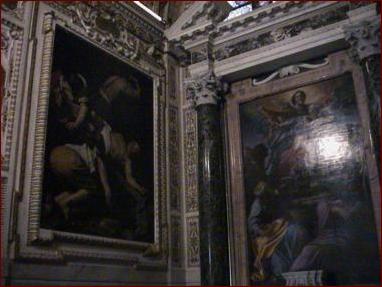 Just to the right of the gate (as we're seeing it from this vantage point) is the Chiesa del (Church of) Santa Maria del Popolo. From an art history point of view, this is one of the more important Roman churches. Much of the interior was decorated by Pinturicchio, including a series of mosaics along the apse ceiling. The Chigi Chapel was designed by Raphael and completed by Bernini. At the far end of the church are two dark alcoves. Dropping spare change into a mechanism turns on several cheap lighting fixtures, after which you can see two Caravaggios. (None of the other tourists seemed to know these masterpieces were here.) At left is The Crucifixion of St. Peter, realistic, including dirt on the saint's feet and an unpleasant facial expression appropriate to the event. At right is The Conversion of St. Paul, which captures the saint's state of mind at a crucial moment in his spiritual maturity.
Just to the right of the gate (as we're seeing it from this vantage point) is the Chiesa del (Church of) Santa Maria del Popolo. From an art history point of view, this is one of the more important Roman churches. Much of the interior was decorated by Pinturicchio, including a series of mosaics along the apse ceiling. The Chigi Chapel was designed by Raphael and completed by Bernini. At the far end of the church are two dark alcoves. Dropping spare change into a mechanism turns on several cheap lighting fixtures, after which you can see two Caravaggios. (None of the other tourists seemed to know these masterpieces were here.) At left is The Crucifixion of St. Peter, realistic, including dirt on the saint's feet and an unpleasant facial expression appropriate to the event. At right is The Conversion of St. Paul, which captures the saint's state of mind at a crucial moment in his spiritual maturity.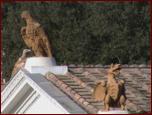 We leave the church and head toward the hill, the Villa Borghese. We take several footpaths, with some steep switchbacks. It's an unseasonably hot morning, and there are good views of buildings, statues, and cityscapes; it takes us a few minutes to make our way uphill. Isaac has a great time hiding behind the statues we encounter along the way. As we get to the top of the rise we see gargoyles and griffins on the roof of a building by which we just walked. A few more steps and we come across a good vantage point of the Piazza del Popolo.
We leave the church and head toward the hill, the Villa Borghese. We take several footpaths, with some steep switchbacks. It's an unseasonably hot morning, and there are good views of buildings, statues, and cityscapes; it takes us a few minutes to make our way uphill. Isaac has a great time hiding behind the statues we encounter along the way. As we get to the top of the rise we see gargoyles and griffins on the roof of a building by which we just walked. A few more steps and we come across a good vantage point of the Piazza del Popolo.  Looking down from the vantage point I see a group of nuns on their way. We saw a lot of Roman Catholic clergy around the city, and a smaller number of Jesuits. We also visited the synagogue, but that's a story for another page.
Looking down from the vantage point I see a group of nuns on their way. We saw a lot of Roman Catholic clergy around the city, and a smaller number of Jesuits. We also visited the synagogue, but that's a story for another page. We walk along well-manicured paths, under the spreading arms of huge trees, until we come across one of two water-clocks to be found in Rome. (The other one, no longer functioning, may be found in the courtyard of Via del Gesu 62.) This clock, still functioning, was constructed by Giambattista Embriaco (frate Domenicano) in 1867. It's an amazing work of art and science; highly recommended.
We walk along well-manicured paths, under the spreading arms of huge trees, until we come across one of two water-clocks to be found in Rome. (The other one, no longer functioning, may be found in the courtyard of Via del Gesu 62.) This clock, still functioning, was constructed by Giambattista Embriaco (frate Domenicano) in 1867. It's an amazing work of art and science; highly recommended.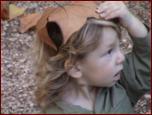
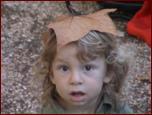 Isaac had a great time in the Villa Borghese. He loved the tree-lined paths and the friendly, well-dressed people on bicycle. Piles of leaves beg for a small child to jump all over them; these were satisfied :-) A particularly large leaf became a hat. We had a delightful lunch at the café in the park; amatriciana is hard to screw up even for those with a limited kitchen.
Isaac had a great time in the Villa Borghese. He loved the tree-lined paths and the friendly, well-dressed people on bicycle. Piles of leaves beg for a small child to jump all over them; these were satisfied :-) A particularly large leaf became a hat. We had a delightful lunch at the café in the park; amatriciana is hard to screw up even for those with a limited kitchen.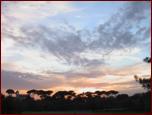 After lunch we strolled around, crossing the Viale del Muro Torto, looking at the gazebos and reconstructions of ancient buildings. We made it to the Piazza di Siena, an oval racetrack kind of thing, before we turned south. Because it was a weekday, and during the off season, we had the park pretty much to ourselves. The sun was setting, giving us beautiful streaked skies and cool shadows at our feet. A peaceful way to end a walkabout. Soon we were at the Porta Pinciana, one of the gateways through the old city wall. These days it has four lanes of automotive traffic going through its portals.with I'm very impressed at the seemingly good condition of the walls, what with all the pollution eating away at ancient stoneworks.
After lunch we strolled around, crossing the Viale del Muro Torto, looking at the gazebos and reconstructions of ancient buildings. We made it to the Piazza di Siena, an oval racetrack kind of thing, before we turned south. Because it was a weekday, and during the off season, we had the park pretty much to ourselves. The sun was setting, giving us beautiful streaked skies and cool shadows at our feet. A peaceful way to end a walkabout. Soon we were at the Porta Pinciana, one of the gateways through the old city wall. These days it has four lanes of automotive traffic going through its portals.with I'm very impressed at the seemingly good condition of the walls, what with all the pollution eating away at ancient stoneworks. 
|
| Have you found errors nontrivial or marginal, factual, analytical and illogical, arithmetical, temporal, or even typographical? Please let me know; drop me email. Thanks! |